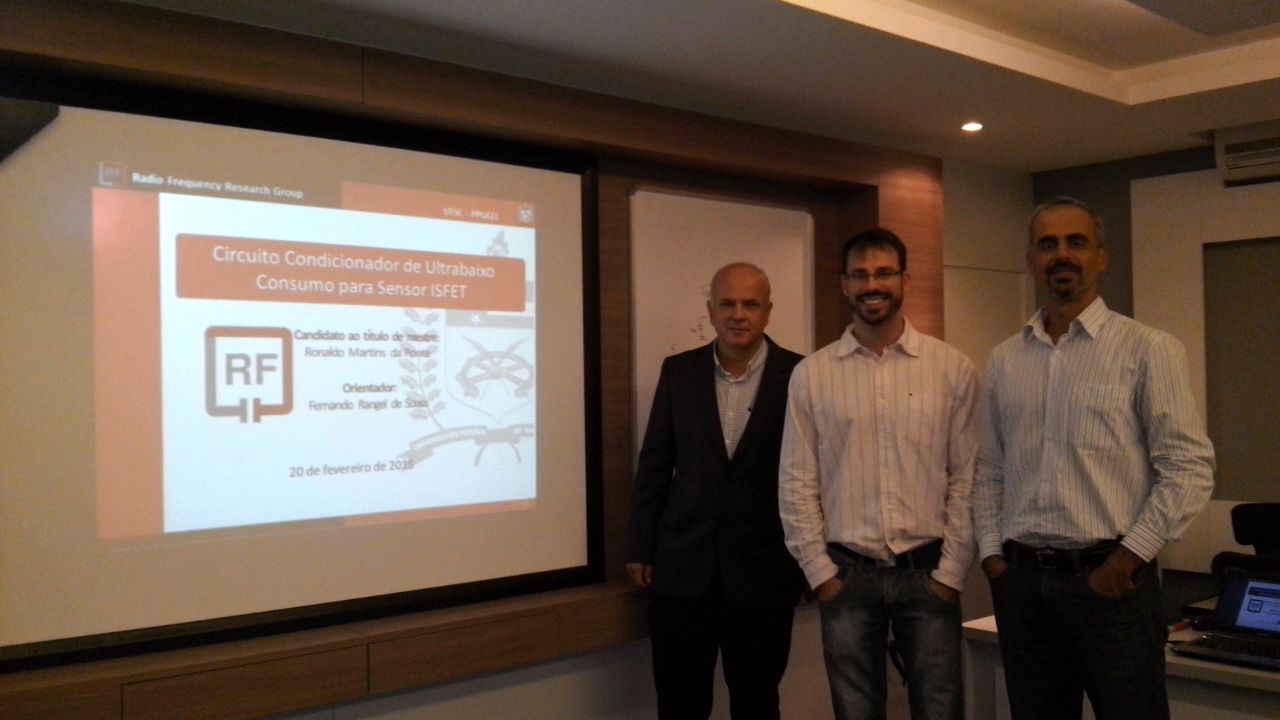The paper “A 25-dBm 1-GHz Power Amplifier Integrated in CMOS 180nm
for Wireless Power Transferring“was awarded as the third best paper of the
28th Symposium on Integrated Circuits and Systems Design. (slides here)

O mestrando Ronaldo Martins da Ponte defendeu sua dissertação de mestrado:CIRCUITO CONDICIONADOR DE ULTRABAIXO CONSUMOPARA SENSOR ISFET.


DOI: 10.1049/el.2014.3800
 DOI: 10.1007/s10470-014-0473-z
DOI: 10.1007/s10470-014-0473-z

Renato Feitoza presented his Final Year Project on Metamaterial-Inspired Sensors entitled: “ Design of miniaturized antennas based on metamaterials for passive sensing applied to internet of things (IoT) “. (pdf)

These people are very proud of being THE RF RESEARCH GROUP at UFSC.
We are offering two opportunities for research assistants in undergraduate level (BOLSA DE INICIAÇÃO CIENTÍFICA). The selected candidates will do research on the following subjects:
- Energy Harvesting
- RFIC built-in selft-test and self-repair
- RF instrumentation and measurement
Context: Ultra low power devices for Wireless Body Area Networks (WBAN). For medical applications the consumption
is the most critical design parameter, especially in implanted devices where it is inconvenient or impossible to replace the
battery. Therefore, we try to employ solutions such as: battery recharging via energy transfer or magnetic coupling, harvest of available energy in the environment.
PIBIC Requirements.
- Full time undergraduate student (without other grant or work) whit interest in developing research activities (20 hours per week).
- IA (IAA) more than 7.
- Have done at least one course of electrical circuits.
- Skills which are relevant:
- Independence: being able to work without close supervision, managing your own time and projects.
- Critical thinking: being able to evaluate your work and that of others, making judgments about the value of information and drawing conclusions from data.
- Problem solving: working without “a right answer” and devising strategies to work towards a solution.
- Contributing as a professional: presenting work to your peers, managing discussions and defending your position, having the confidence to put forwards ideas to senior staff.
- Initiative: having the confidence to make decisions and act on them, not waiting for approval to do basic tasks, but reporting back responsibly at appropriate times.
Some PIBIC Benefits
- Favorable framework to develop research abilities such as: research methods, problem solving, argument construction, preparation and prioritization, and time management.
- The “Ciência sem fronteiras” program prefers the candidates who have been enrolled in some scientific initiation program.
- Grant for twelve (12) months beginning on August (2014).
What to do?
You must send email with your resume (showing your skills, experience, and achievements) to schedule an appointment for the personal interview, before 22 july.
These interviews will be on 24 and 25 july (2014).
Contact :
Arturo Fajardo. arfaja1979@gmail.com
Paulo Marcio Moreira. p.marcio.moreira@gmail.com
Or, send us a message using the form found here.

The paper “An RF-Powered Temperature Sensor Designed for Biomedical Applications” by Gustavo Campos Martins and Fernando Rangel de Sousa won the SBCCI 2013 Best Paper Award!

Gustavo Campos defended his master thesis intitled: “RF-Powered CMOS Temperature Sensor“. His work presents the development of a wirelessly powered CMOS temperature sensor, designed to measure temperatures in the human body temperature range. The sensor receives energy through an RF signal emmited by a reader device. Once the sensor has enough energy, it sends data about the measured temperature to the reader. The system was designed to operate with signal levels as low as −10dBm centered at 900MHz. The sensor device is formed by the following circuits: rectifier, voltage limiter, reference source, operating mode selector, voltage regulator, oscillator and backscattering device. The system presented 8.5μA current comsumption in active mode and 4.9μA in standby mode. The developed sensor contains a calibration method, which was designed to achieve maximum temperature measurement error of 0.2 C.

Our integrated RF harvester for WBAN sensors was tested in a chip-on-board prototype. It is going to be used in a body temperature sensor.

Miniaturization is a primary concern today in communication
and biomedical systems. A highly miniaturized antenna
with electrical length 0.036λ x 0.044λ x 0.005λ
(11.25mm×13.80mm×1.55mm) was implemented based on
the zeroth-order resonance approach. The experimental resonance
frequency presented a slight shift to the right due to the
limited resolution of the fabrication process. The detailing of
the design methodology presented here can be a useful guide to
antenna designers who are working on miniaturized antennas.

Our work on low-power oscillator was presented at ISCAS2013 in Beijing-China. We presented a technique to improve the negative conductance of amplifiers in order to decrease the power consumption of single-transistor CMOS oscillators.
Mateus Bernardino, MSc. student at GRF, won the SIM 2013 best paper award with the work “A 2.4 GHz Fully-Integrated CMOS Class-AB Power Amplifier“.


We achieved an important milestone of our WBAN roadmap. The UHF energy harvesting designed to power on-body sensors was tested and worked as expected!

We received new chips containing our last designs. The circuits are under test in the laboratory!
 Today, the graduate student Roddy Romero defended his master’s thesis entitled “Duty-Cycle Controlled Variable-Gain”.
Today, the graduate student Roddy Romero defended his master’s thesis entitled “Duty-Cycle Controlled Variable-Gain”.































